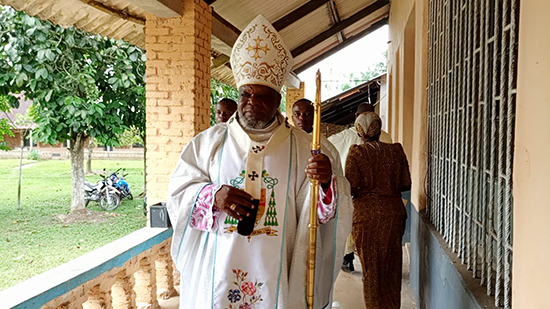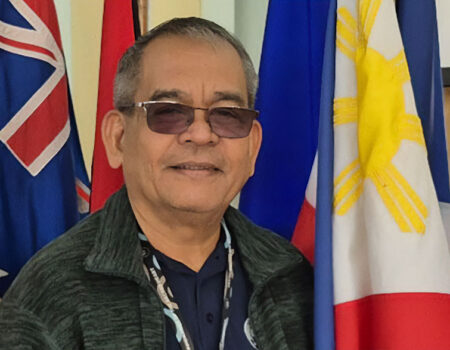The centenary of the Missionaries of the Sacred Heart in the D.R. Congo: 1924-2024
Tuesday October 1, 2024

The Missionaries of the Sacred Heart were among the first religious congregations to evangelise the north-west of the Belgian Congo, now the Democratic Republic of Congo (DRC). Their arrival was part of the expansion of Catholicism to many parts of Africa between the two world wars. On Congolese soil, the private property of the Belgian King Leopold II, the arrival and presence of ‘missionaries without borders’ seemed necessary to put into practice the motto of their founder, Jules Chevalier: to make the Sacred Heart of Jesus loved everywhere.
Before the Missionaries of the Sacred Heart arrived, the King of Belgium had urged Pope Leo XIII to put pressure on the monks who, in the Middle Ages, had done much to ‘clear the wastelands of Europe’. As a result, the Wesmalle Trappists agreed to open a mission in the vicinity of Coquilhatville, in Bamanya, the first Christian village in the northwest region of the DRC. For these contemplative Trappists, founding a mission and carrying on the very active work of the missions was a significant challenge, for this mission seemed contrary to the spirit of the order. At a chapter in Rome, these monks decided to hand over their evangelising missionary work to an active apostolic congregation: the Missionaries of the Sacred Heart (MSC). The Trappist missionaries who wished to continue the mission in the Congo chose to become Missionaries of the Sacred Heart (MSC). In 1924, Rome granted the young Belgian MSC province its own mission field in the Belgian Congo: the apostolic prefecture of Tshuapa, in the province of Equateur.

The year 1924 thus marked the departure of the first three Belgian Missionaries of the Sacred Heart on Congolese soil. Father Edouard Van Goethem and two MSC confreres (Louis Vertenten and E. Van der Kinderen) embarked at the port of Antwerp on 23 September. In 1929, Father Nicolas Bovy, Belgian provincial of the Missionaries of the Sacred Heart, had to abandon the Flemish Work in Wallonia to make many missionaries available to the new mission land. In 1966, the Belgian National Documentation Centre published statistics that ranked the Belgian Missionaries of the Sacred Heart 9th in terms of personnel among the thirty-four Belgian religious orders and congregations listed in the former Belgian colony.
In 1933, the Apostolic Prefecture was upgraded to an Apostolic Vicariate. Mgr Van Goethem was, therefore, appointed bishop. In 1950, the number of priests on mission increased to more than fifty: they were divided between fifteen mission stations, including two leprosaria. In addition to the Missionaries of the Sacred Heart, there was a group of ‘Brothers of the Christian Schools’, who were very active in teaching, as well as a good number of nuns, in particular the Daughters of Our Lady of the Sacred Heart, who had arrived in the Belgian Congo in 1925. From the 1950s (1955), the MSC province of Bavaria-Austria began to take part in missionary work in the Belgian Congo. Bishop Vermeiren, MSC, entrusted them with the entire eastern part of the mission. There were already 13 Fathers and two Missionary Brothers of the Sacred Heart in just four years. In 1961, their mission was detached from the former Vicariate of Coquilhatville. As a result, it became an autonomous diocese with the double name of ‘Bokungu-Ikela’.
For the Missionaries of the Sacred Heart in the DRC, 2024 has a particular connotation: their mission’s centenary and presence on Congolese soil is being celebrated. The duty of ‘remembering’ is on the agenda. In the DRC, two celebrations mark this historic event: the opening of the jubilee year in Bamanya and its closing in Kinshasa in December. Bamanya is a village ten kilometres from Mbandaka in Equateur province. The Missionaries of the Sacred Heart are still present there: they serve a parish and welcome aspirants. The MSC also look after the Aequatoria library. It was founded by Father Gustave Hulstaert, who spent most of his life there and died in 1990. Here are the activities organised at Bamanya to mark the opening of the jubilee year, celebrated on 7 April 2024: teachings on the Msc (arrival in Congo, charism, spirituality, mission, formation, etc.), exhibitions, cultural activities and the grand Eucharistic celebration presided over by Archbishop Ernest Ngboko of Mbandaka-Bikoro. This centenary is also being celebrated by the Trappist monks of Wesmalle in Belgium. On 12 August, the feast day of Blessed Isidore Bakanja (+1909), a delegation of MSCs and diocesans from Mbandaka-Bikoro visited the Notre Dame du S. Coeur monastery run by the Trappist Fathers. Coeur monastery of the Trappist Fathers in Westmalle to celebrate this blessed day of the Blessed, who the Trappists baptised, and to give thanks with the monks for the mission in Congo-Coquilhatville, which the Belgian MSCs have inherited since 1924.

There is now only one European Missionary of the Sacred Heart in the D.R. Congo, Father Peter Laschan (80), from the Province of South Germany-Austria, who is a member of the Union by convention. We recall that the provinces of Belgium, South Germany, and Austria formed two regions. In 1986, after the great assembly of the MSC in Boende, the Missionaries of the Sacred Heart of the Congolese region joined forces with the Missionaries of the Sacred Heart of the Province of France-Switzerland. At the time, the latter were working in Senegal and Cameroon. The first Congolese MSC priest, Boniface Kamay, was ordained to the priesthood in 1986 on behalf of the MSCs of South Germany/Austria. The number of MSCs in the DRC has declined due to the country’s various wars. Today, the MSC District of Congo has more than fifty confreres (priests and brothers) in perpetual vows, including a bishop appointed to the Diocese of Bokungu-Ikela. Congolese MSCs work in the two Congos, Cameroon, Senegal, North America and Europe. They work in parish ministry and support movements linked to the spirituality of the Heart. They are also involved in the education and training of young people and in caring for the sick and vulnerable. The MSC District of Congo has several young people in training in Cameroon and the DRC.
The pioneering days are over. The mission is in the hands of the African Missionaries of the Sacred Heart. In their missionary commitment and evangelising work, the Congolese MSCs perpetuate the spirituality of the Heart. Today, they are actively involved in Congolese society to meet challenges such as the quality of education, scientific and vocational training for young people, the installation of boreholes for drinking water, and support for single mothers.
The jubilee year of the MSCs’ presence and mission is due to end in Kinshasa on 08 December 2024. So, from now on, each of them is invited to pay more attention to the following aspects: evangelical fraternity, missionary responsibility, personal commitment (as religious in the apostolates linked to our charism), and particular sensitivity to the issues of inclusion of marginalised people and ecology.
Finally, a huge thank you to all our MSC colleagues who agreed to leave their Western countries to come and share the precarious and austere human conditions of our Congolese people. Much courage to all the MSCs working in challenging conditions to fulfil their vocation. The missionary obstacles we encounter could be opportunities to accomplish God’s work of love. Our dear founder used to say: ‘As long as God’s hand is with us, trust is a duty’. Let us trust in God; let us trust in every MSC working on Congolese soil; let us trust in the future.
Lazare Elenge, MSC





